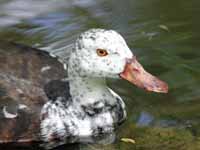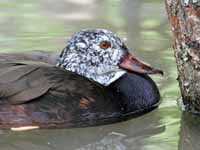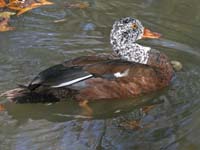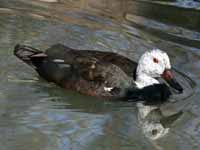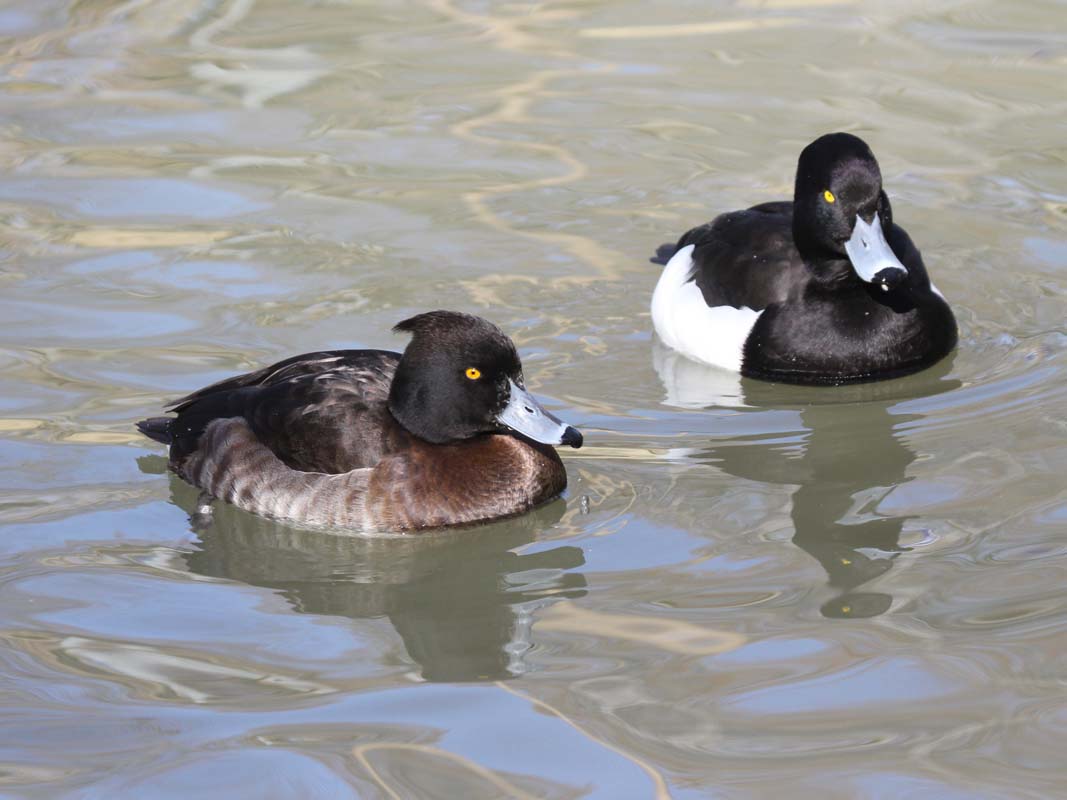The term waterfowl is used to describe any member of the order Anseriformes. A series of articles describes all the waterfowl. This specific article describes the "diving ducks " which belong to family Anatidae, subfamily Aythyinae.
Anseriformes
Most species of the order Anseriformes spend a considerable amount of time in water. In fact, they are called waterfowls. Their webbed feet make for efficient swimming. A few species spend little time in water and thus their feet are only partially webbed. Most waterfowl are also good flyers, many migrating long distances to escape the cold and others migrating shorter distances for optimizing their food supply. All species, except the screamers, have a wide and relatively flat bill. The shape of a species bill and also their tongue is a function of their diet. Considering the entire order, they eat aquatic plants, grasses, sedges, algae, plankton, insects, insect larvae, mollusks, crustaceans, fish, fruits, grains, rice. Most species are monogamous and if they lose a partner seem to mourn. Males are larger and heavier than females. The chicks are well developed when they hatch and can walk almost immediately.
The order Anseriformes has 3 familes: Anatidae, Anhimidae, Anseranatidae. Family Anatidae is comprised of the ducks, swans, and geese which amounts to about 160 species. Family Anhimidae is made up of 3 screamer species while family Anseranatidae has only one species, the magpie goose. Since these latter two families contain so few species, it seems appropriate to consider the entire order in this series of articles.
Anatidae
The Anatidae family has the following subfamiles:
Anatinae: dabbling ducks and teals
Anserinae: geese, swans
Aythyinae: diving ducks
Dendrocygninae: whistling ducks
Merginae: sea-ducks
Oxyurinae: stiff-tailed ducks
Plectropterinae: spur-winged goose
Stictonettinae: freckled duck
Tadorninae: shelducks, shelgeese
Diving Ducks
The diving ducks, commonly called pochards or scaups, are a category of duck which feed by diving beneath the surface of the water. They are mainly found in the northern hemisphere. To aid in their swimming under water for food, diving ducks tend to be denser than dabbling ducks, have large heads, and their legs placed further back on their body. Must are shallow divers, but the greater scaup will dive up to 6 meters (20 ft). They are ungainly walking on ground and their takeoff for flying is labored. The diving ducks are placed in 4 genera, with the majority of the 17 species place in either Aythya or Netta. Those in Netta tend to "dabble" more often then dive, but are still referred to as diving ducks.
All diving ducks live near water and do most of their foraging at waterbodies. Shallow wetlands are preferred, but most important is that there is abundant vegetation, both submerged and emergent. During the breeding season, freshwater is almost exclusively visited. During the winter season, brackish and saline wetlands are added to the sites of many of the diving species.
Some diving ducks are mainly vegetarians eating roots, tubers, green mateiral seeds. Others eat more animal material than vegetable. These diets includes aquatic insects and their larvae, mollusks, small fish, snails, crustaceans. The tendency to be non-vegetarian is greater in the breeding season because a higher protein diet can be required by juveniles and also mothers.
All diving ducks are strong flyers and those that live in the northern hemisphere are migratory; breeding in more northern climates and wintering where it is warmer and the vegetations still growing. The few that live in the southern hemisphere are generally non-migratory. The white-eyed duck of Australia will travel to avoids droughts. The New Zealand scaup will move if the ponds freeze. The rosy-billed pochard of South America is partially migratory, those birds in the southern part of the continent do migrate to warmer climates in the winter. The southern pochards of both South America and Africa are mainly sedentary, but move some during droughts.
The males of these species average larger than the females. The also exhibit dimorphism - the sexes look very different. During breeding season their looks differ the greatest. that way a female has no trouble telling the difference between a mature male and a juvenile. The diving ducks have two exceptions: the teal duck and the white-winged duck are not dimorphic.
Genus Aythya
Canvasback Aythya valisineria
Description: The canvasback is the largest North American diving duck. It eats mainly by diving, but also by dabbling. It has a wedge shaped head with a large black bill. The male has a black breast and rump; a chestnut head and neck. The back, flanks, and belly are whitish. This white has fine irregular lines lika a canvas, hence the name. Its eyes are red in the summer, but duller other times. The female has greyish-brown upperparts. the head, neck, and breast are brown. The canvasback is similar to the redhead, but their bills are very different.
Range: North America.
Habitat: During the breeding season it prefers wetlands with emergent vegetation. At other times it will also frequent saltwater and brackish estuaries.
Diet: Mainly vegetarian: tubers, roots, leaves, buds, seeds. Also snails, insect larvae, snails. Its bill is used to dig its favorite meal - tubers.
Conservation status: Least Concern.
Image by: 1) Judy_Gallagher - Maryland 2, 3, 4) Dick Daniels - Sylvan Heights Range: North America.
Habitat: During the breeding season it prefers wetlands with emergent vegetation. At other times it will also frequent saltwater and brackish estuaries.
Diet: Mainly vegetarian: tubers, roots, leaves, buds, seeds. Also snails, insect larvae, snails. Its bill is used to dig its favorite meal - tubers.
Conservation status: Least Concern.
1, 2) Female 3, 4) Breeding male
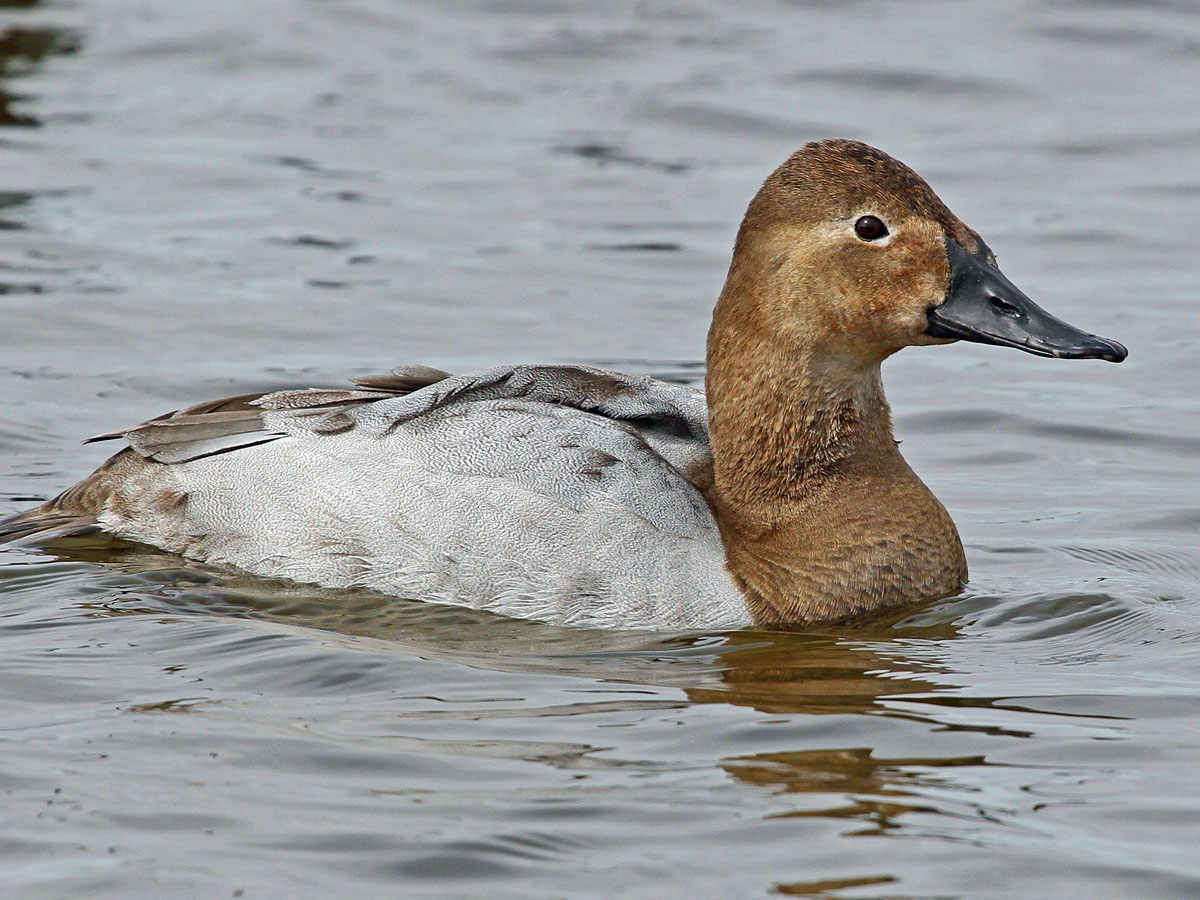
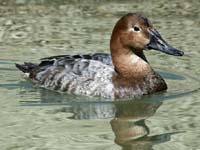
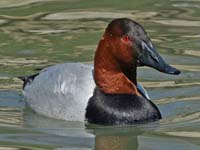
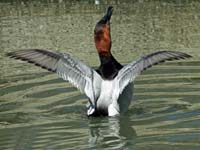
Duck,_Ferruginous Aythya nyroca
Description: The ferruginous duck is also known as the ferruginous pochard. The male ferruginous duck has chestnut head, sides, and underparts. The back is brown, the eyes yellowish, and the under-tail white. The fight feathers are also white. The female is similar but duller and has dark eyes. The ferruginous duck is similar to the white-eyed duck which has some white on the bill; the ferruginous duck does not. Their ranges do not overlap.
Range: Europe, Asia.
Habitat: Freshwater wetlands with submerged and floating vegetation. Also likes saline and brackish waters, especially in the winter.
Diet: Aquatic plants, insects, mollusks, crustaceans, fish.
Conservation status: The ferruginous duck is Near Threatened because of habitat reduction and destruction.
Image by: 1) GrahamC57 - England 2, 3) Dick Daniels - Sylvan Heights 4) Imran_Shah - PakistanRange: Europe, Asia.
Habitat: Freshwater wetlands with submerged and floating vegetation. Also likes saline and brackish waters, especially in the winter.
Diet: Aquatic plants, insects, mollusks, crustaceans, fish.
Conservation status: The ferruginous duck is Near Threatened because of habitat reduction and destruction.
1, 2) Female 3, 4) Male
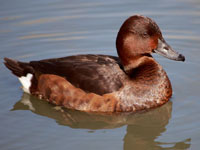
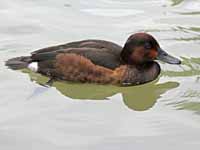
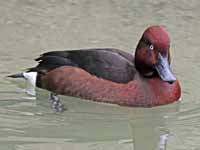
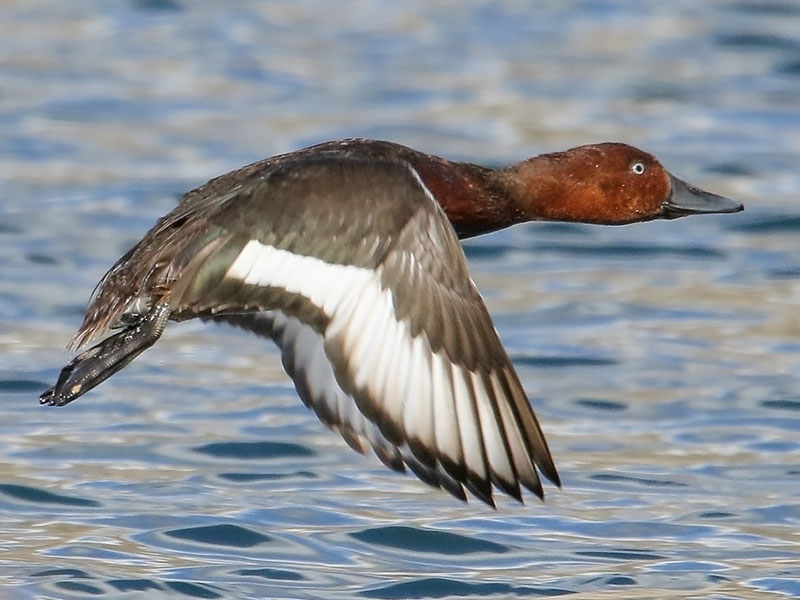
Duck, Ring-necked Aythya collaris
Description: The ring-necked duck has a difficult to observe cinnamon neck ring. It has a white band near the tip of its grey bill and a white ring near the base of the bill. The male has shiny black upperparts, head, neck, and breast. It has greyish-white sides and belly. The female has mainly brown plumage. The head is grey-brown and there is a white eye-ring. The white band on the bill is sufficient to identify the ring-necked duck from other simiar species such as the tufted duck or the redhead.
Range: North America, South America (rare), Europe (rare).
Habitat: During breeding season it prefers wooded lakes or ponds in the northern United States and Canada. Migrates south in winter still preferring freshwater wetlands, but also some brackish sites. Avoids saline habitats.
Diet: Submerged and emergent aquatic plants, clams, snails. Juveniles need protein from snails, insects, worms.
Conservation status: Least Concern.
Image by: 1, 2) Alan D Wilson - Near San Diego, California 3) Hilary Chambers - United Kingdom 4) Chad KingRange: North America, South America (rare), Europe (rare).
Habitat: During breeding season it prefers wooded lakes or ponds in the northern United States and Canada. Migrates south in winter still preferring freshwater wetlands, but also some brackish sites. Avoids saline habitats.
Diet: Submerged and emergent aquatic plants, clams, snails. Juveniles need protein from snails, insects, worms.
Conservation status: Least Concern.
1 - 3) Female 4 - 6) male
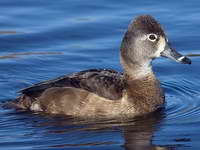
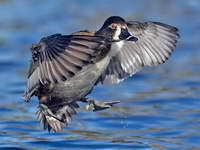
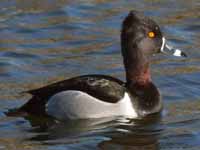
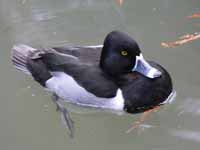
Duck, Tufted Aythya fuligula
Description: The Tufted Duck has a tuft at the back of its head. It has yellow eyes and a blue-grey bill with a black tip. The male has mainly black plumage. The flanks and belly are white as are part of the flight feathers. The male in eclipse plumage is similar to female, except blacker. The female is brown with darker head and back plus a whitish belly. The similar ringed-neck Duck has a white band near the tip of the bill and a white ring near the base of the bill. The similar lesser scaup and greater scaup females have substantial white at the base of their bills.
Range: North America, Europe, Asia, Africa .
Habitat: Stays close to freshwater wetlands with vegetation to conceal the nest. During nonbreeding season will use freshwater or coastal wetlands.
Diet: Mollusks, aquatic plants, crustaceans. Dives for food, but also dabbles.
Conservation status: Least Concern.
Image by: 1) Namisao 2, 3) Dick Daniels - Sylvan
Heights 4) Imran_Shah - PakistanRange: North America, Europe, Asia, Africa .
Habitat: Stays close to freshwater wetlands with vegetation to conceal the nest. During nonbreeding season will use freshwater or coastal wetlands.
Diet: Mollusks, aquatic plants, crustaceans. Dives for food, but also dabbles.
Conservation status: Least Concern.
1) Female 2) Eclipse maile 3, 4) Male
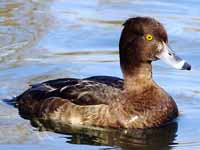
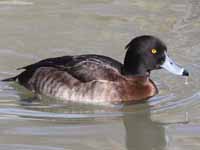
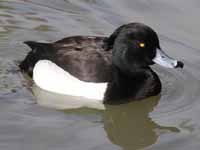
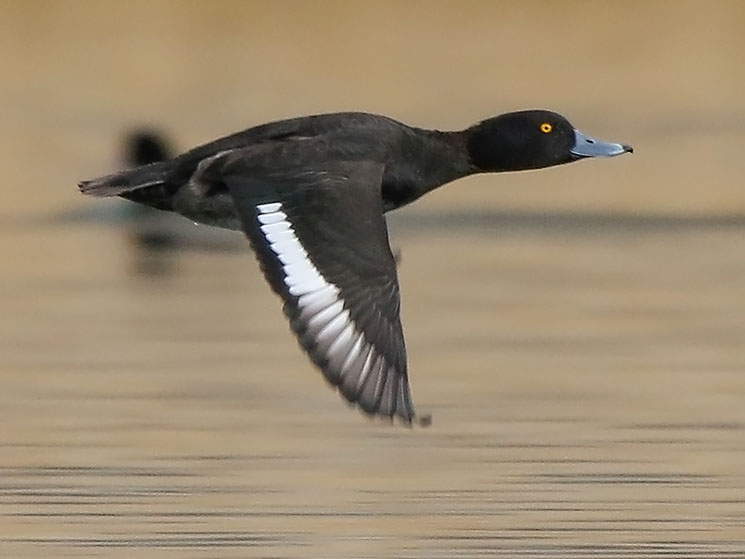
Duck, White-eyed Aythya australis
Description: The white-eyed duck, also known as the hardhead, is the only diving duck in Australia. It has chocolate-brown upperparts. The breast and flanks are rufous. The belly, under-tail, and under-wings are white. The male has bright white eyes and the female has brown eyes. It is similar to the ferruginous duck which has no white on the bill while the white-eye duck has some white on there. Their ranges do not overlap.
Range: Australia, New Zealand, and Pacific Islands.
Habitat: Prefer larger lakes, swamps and rivers with deep, still water, but are often seen in smaller streams, flooded grasslands, and shallow pools. As a general rule, they avoid coastal waters.
Diet: Aquatic plants, insects, mollusks, crustaceans, fish. Forage almost entirely by diving.
Conservation status: Least Concern.
Image by: 1) JJ_Harrison 2 ) Oystercatcher 3) Dick Daniels - Sylvan
Heights
4) Dick Daniels - Featherdale Wildlife Park, Australia Range: Australia, New Zealand, and Pacific Islands.
Habitat: Prefer larger lakes, swamps and rivers with deep, still water, but are often seen in smaller streams, flooded grasslands, and shallow pools. As a general rule, they avoid coastal waters.
Diet: Aquatic plants, insects, mollusks, crustaceans, fish. Forage almost entirely by diving.
Conservation status: Least Concern.
1, 2) Female 3, 4) Male
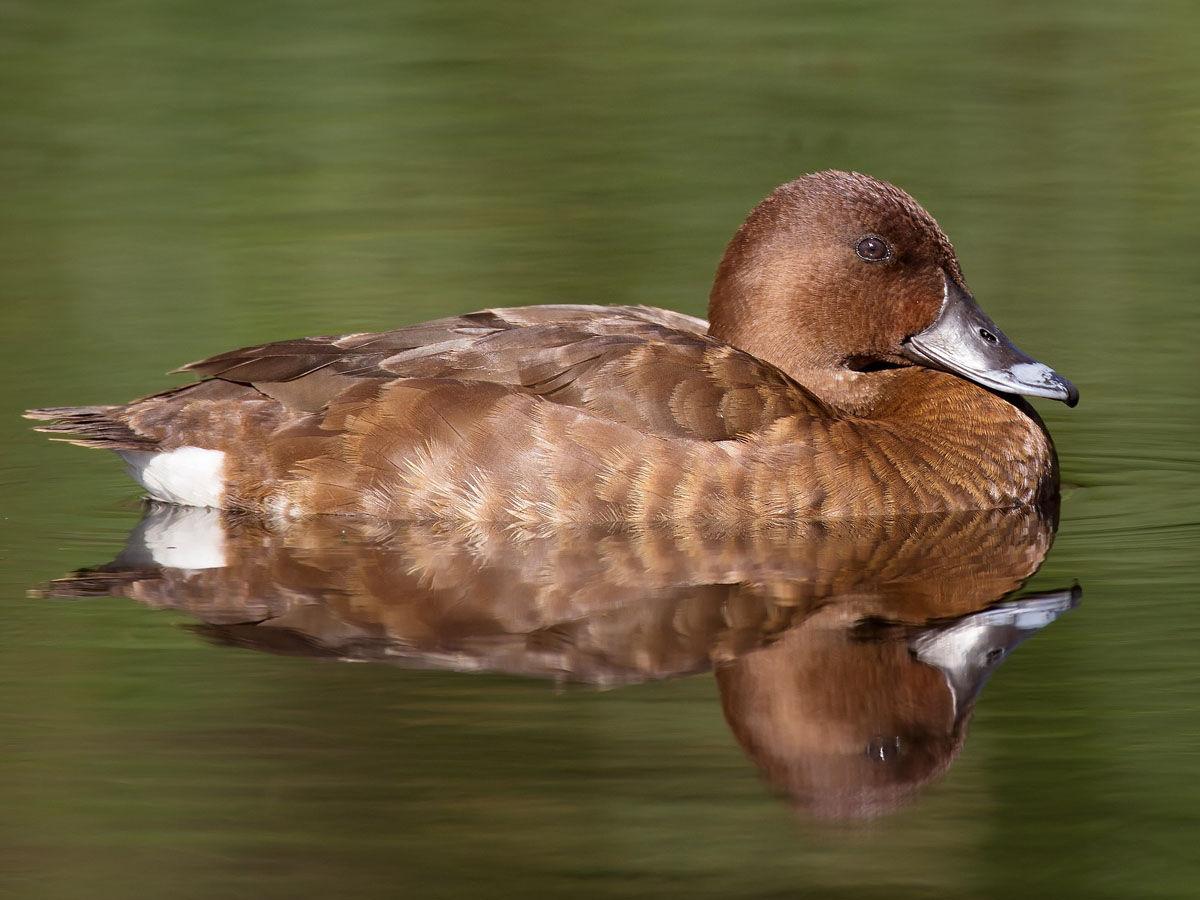
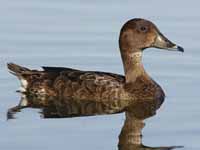
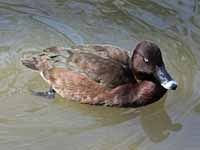
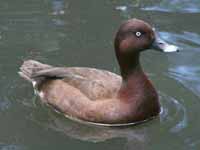
Pochard, Baer's Aythya baeri
Description: The breeding male Baer's pochard has a black mantle and brown lower back. The head and neck are dark green. It has a chestnut breast, chestnut fading to white flanks, white belly, and white flight feathers. The male has white eyes, and bluish-grey bill with a black tip. Female has a blackish-brown back and head. The breast and sides are chestnut. The eyes are dark and the bill similar to the male's. The eclipse male is similar to the female, but the eye remains white.
Range: Asia.
Habitat: During the breeding season, small wetlands with vegetation. Other times prefers larger waterbodies. Will frequent salt and brackish wetlands.
Diet: Aquatic vegetation obtained by diving. Probably also eats mollusks and crustaceans.
Conservation status: The Baer's pochard is Critically Endangered. Wild population less than 1000 due to hunting and wetland destruction.
Image by: 1, 2)
Dick Daniels - Sylvan Heights Range: Asia.
Habitat: During the breeding season, small wetlands with vegetation. Other times prefers larger waterbodies. Will frequent salt and brackish wetlands.
Diet: Aquatic vegetation obtained by diving. Probably also eats mollusks and crustaceans.
Conservation status: The Baer's pochard is Critically Endangered. Wild population less than 1000 due to hunting and wetland destruction.
1, 2) Male
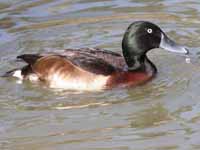
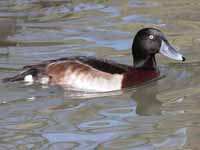
Pochard,_Common Aythya ferina
Description: The male common pochard has a red head and neck, black breast and rump, large grey band on the dark bill, and red eyes. The back is light grey with vermiculation and the belly is light grey. The female has a brown head, neck, and breast, light brown back, and a narrow grey band on the bill.
Range: Europe, Asia, Africa.
Habitat: Wide range of wetlands, mainly freshwater but also saline and brackish. Prefer the water to be more than a meter deep.
Diet: Mainly aquatic plants. Also mollusks, aquatic insects, fish. Forages mainly by diving.
Conservation status: The common pochard is Vulnerable due to habitat modification from development, and also due to hunting.
Image by: 1) sebastien_bertru - France 2) Imran_Shah - Pakistan 3) Jan_Svetlik 4) Richard Barrett-Small Range: Europe, Asia, Africa.
Habitat: Wide range of wetlands, mainly freshwater but also saline and brackish. Prefer the water to be more than a meter deep.
Diet: Mainly aquatic plants. Also mollusks, aquatic insects, fish. Forages mainly by diving.
Conservation status: The common pochard is Vulnerable due to habitat modification from development, and also due to hunting.
1, 2) Female 3, 4) Male
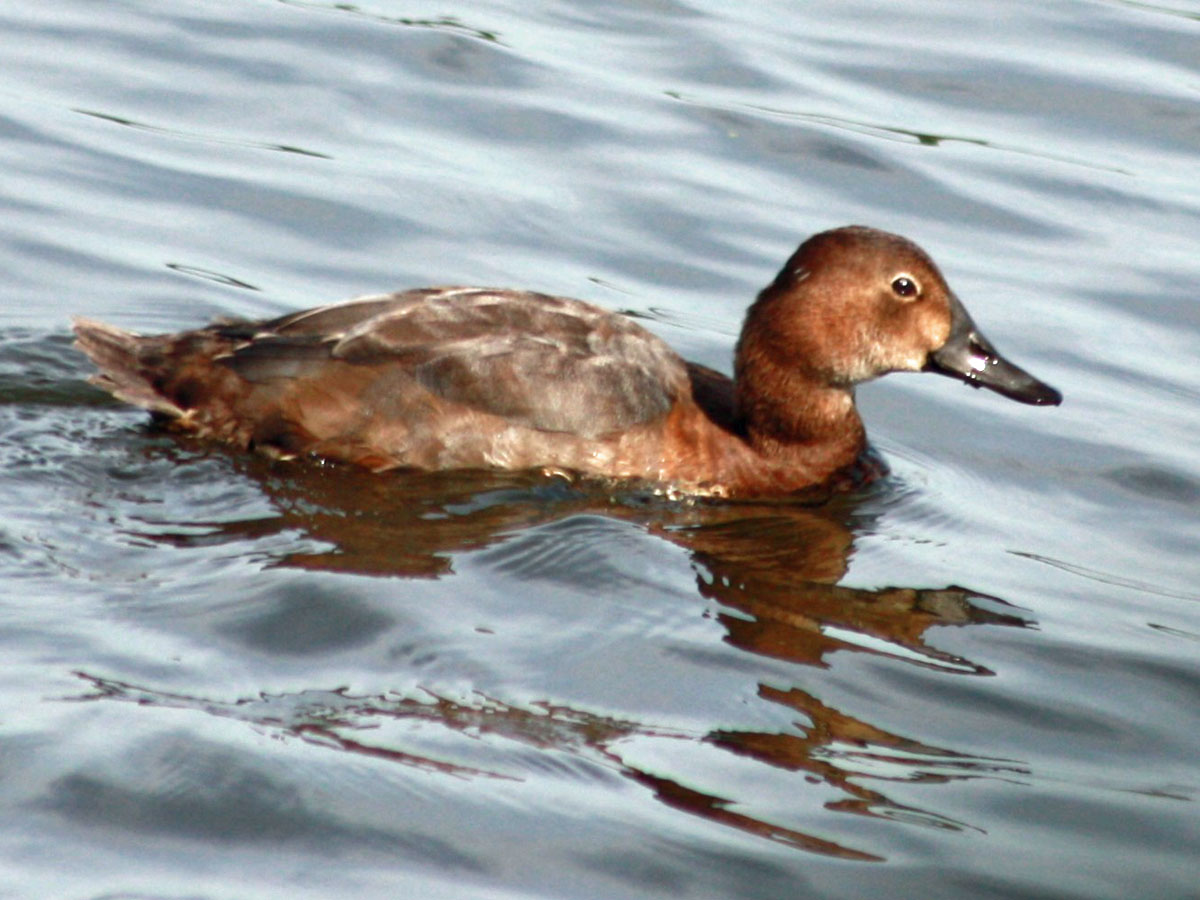

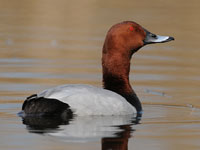

Pochard,_Madagascar Aythya innotata
Description: The male Madagascar pochard has dark brown upperparts. The head, neck, and breast are chestnut. There is a white belly and his eye are also white. The female is similar with brown eyes.
The Madagascar pochard has been deemed extinct a couple of time. Best recent guess is there might be about 50 left in the wild. Male has bright eyes while the female has darker eyes.
Range: Madagascar.
Habitat: Inland wetlands with dense vegetation.
Diet: Thought to be aquatic insects, but more data is needed.
Conservation status: The Madagascar pochard is Critically Endangered due to habitat modification. There are approximately 50 left.
Image by: 1) Amy AcAndrews 2, 3) Frank VassenThe Madagascar pochard has been deemed extinct a couple of time. Best recent guess is there might be about 50 left in the wild. Male has bright eyes while the female has darker eyes.
Range: Madagascar.
Habitat: Inland wetlands with dense vegetation.
Diet: Thought to be aquatic insects, but more data is needed.
Conservation status: The Madagascar pochard is Critically Endangered due to habitat modification. There are approximately 50 left.
1) Female in front 2, 3) Male

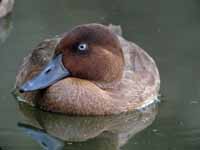
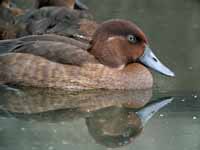
Redhead Aythya americana
Description: The male redhead has a blue bill, red head and neck, black breast, and yellow eyes. The adult female has a brown head and body, darker bluish bill with a black tip, and white eye-rings. The canvasback is similar to the female redhead, but the canvasback has a more massive bill, especially at the base. The females ring-necked duck and redhead are similar, but only the ring-necked has white around the base of the bill.
Range: North America, Asia.
Habitat: Wetlands in non-forested country where the water is deep enough to provide dense emergent vegetation.
Diet: During breeding season snails, mollusks, insect larvae. Also grass, aquatic vegetation. At other times it is mainly vegetarian.
Conservation status: Least Concern.
Image by: 1, 2, 3) Dick - Sylvan
Heights 4) Dick Daniels - Flamingo Gardens, Flroida Range: North America, Asia.
Habitat: Wetlands in non-forested country where the water is deep enough to provide dense emergent vegetation.
Diet: During breeding season snails, mollusks, insect larvae. Also grass, aquatic vegetation. At other times it is mainly vegetarian.
Conservation status: Least Concern.
1, 2) Female 3, 4) Breeding males
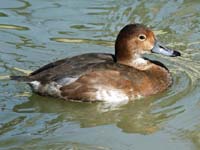
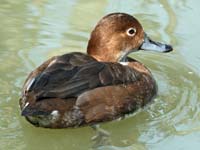
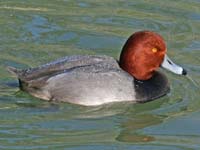
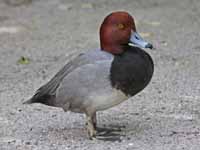
Scaup, Greater Aythya marila
Description: The greater scaup has a rounded head, bluish bill, and yellow eyes. The legs and feet are grey. The male has a black head, neck, breast, and rump. The light grey back is vermiculated (fine wavy lines) and the sides plus belly are white. The female has a dark brown head and back. The breast and sides are lighter brown. She has a bright white area above the bill, The similar male lesser scaup has a blurry border between its black neck and th vermiculated back. The female leser scaup has a dirty white area above its bill.
Range: North America, Europe, Asia, Africa.
Habitat: During the summer, marshy lowland tundra and islands in fresh water lakes. During the winter, coastal bays, estuaries, and sometimes inland lakes
Diet: Aquatic plants, insects, mollusks, crustaceans. Can dive to 6 meters (20 ft) while foraging. During he summer season; prefers
Conservation status: Least Concern.
Image by: 1, 3) Len Blumin - California 2) Shanthanu Bhardwaj - Illinois 4) Calibas - California Range: North America, Europe, Asia, Africa.
Habitat: During the summer, marshy lowland tundra and islands in fresh water lakes. During the winter, coastal bays, estuaries, and sometimes inland lakes
Diet: Aquatic plants, insects, mollusks, crustaceans. Can dive to 6 meters (20 ft) while foraging. During he summer season; prefers
Conservation status: Least Concern.
1) Pair 2) Female 3) Male in eclipse 4) Male
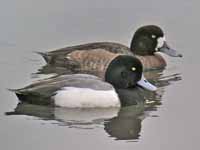
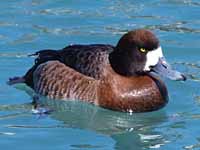
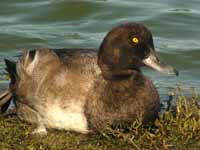
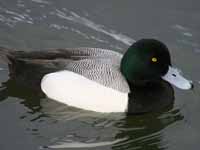
Scaup, Lesser Aythya affinis
Description: The Lesser Scaup has a rounded head, bluish bill, and yellow eyes. Male has a black head, neck, breast, and rump. Its sides and belly are white plus it has a grey back with fine lines. Female has dark brown head and back, lighter brown breast and sides, white area above the bill with some brown mixed in.
Range: North and Central America.
Habitat: During breeding season, fresh or brackish wetlands with emergent vegetation. During the winter, lakes, coastal bays, and estuaries.
Diet: Mainly mollusks, aquatic insects, crustaceans. Also aquatic vegetation, seeds.
Conservation status: Least Concern.
Image by: 1) Dick Daniels - Sylvan Heights 2) New Jersey Birds - California 3) Len Blumin - California 4) Rich LecheRange: North and Central America.
Habitat: During breeding season, fresh or brackish wetlands with emergent vegetation. During the winter, lakes, coastal bays, and estuaries.
Diet: Mainly mollusks, aquatic insects, crustaceans. Also aquatic vegetation, seeds.
Conservation status: Least Concern.
1, 2) Female 3,4) Male
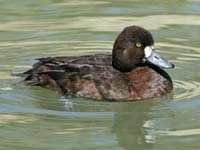
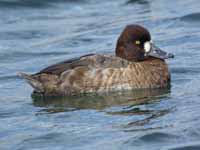
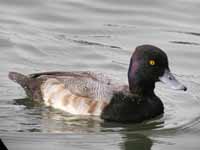
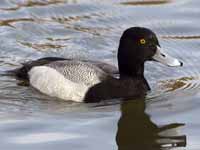
Scaup,_New_Zealand Aythya novaeseelandiae
Description: The New Zealand scaup, also known as the black teal, is dark brown and black with a dark greenish head. The male has yellow eyes, The female is similar to the male, lighter and does not have a yellow eyes. About half the females have white around the bill during breeding season. The female New Zealand scaup has more black on its bill's tip than does the similar female greater scaup
Range: New Zealand.
Habitat: Freshwater wetlands and also coastal lagoons.
Diet: Aquatic plants, small fish, water snails, mussels and insects.
Conservation status: Least Concern.
Image by: 1) Arthur_Chapman 2) Dick Daniels - Sylvan Heights 3) Dick Daniels- Sylvan Heights 4 Dick - New Zealand Range: New Zealand.
Habitat: Freshwater wetlands and also coastal lagoons.
Diet: Aquatic plants, small fish, water snails, mussels and insects.
Conservation status: Least Concern.
1, 2) Female 3, 4) Male
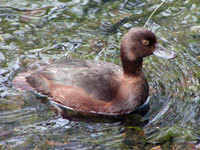

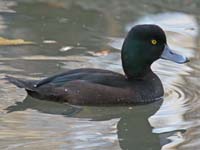
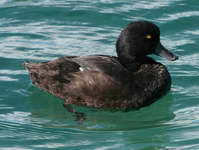
Genus Netta
Netta is a genus of diving ducks. Unlike other diving ducks, the Netta species are reluctant to dive, and feed more like dabbling ducks. Netta ducks do not walk on land as well as dabbling ducks because their legs are placed further back for efficient swimming.These are gregarious ducks, mainly found on fresh water. They are strong fliers, but their broad, blunt-tipped wings require faster wing-beats than those of many ducks and they take off with some difficulty.
Pochard,_Red-crested Netta rufina
Description: The male red-crested pochard has a brown back, reddish-orange head, and red bill. The neck is black. The underparts are black with white flanks and the tail is also black. It has brown forewings and white flight feathers. The female has a dark back and crown; the rest of the head is white. The sides are light brown. She has a black bill with pink tip. The nonbreeding male is similar to the female except he has a red bill.
Range: North America (escapees), Europe, Asia, Africa.
Habitat: Mainly freshwaters with plentiful vegetation. Also brackish waters and estuaries.
Diet: Mainly aquatic plants. Also, crustaceans, fish.
Conservation status: Least Concern.
Image by: 1) 4028mdk09 2, 3)
Dick Daniels - Sylvan Heights 4) Ken_BillingtonRange: North America (escapees), Europe, Asia, Africa.
Habitat: Mainly freshwaters with plentiful vegetation. Also brackish waters and estuaries.
Diet: Mainly aquatic plants. Also, crustaceans, fish.
Conservation status: Least Concern.
1, 2) Female 3, 4) Male
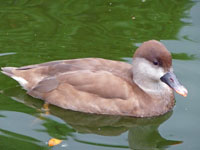
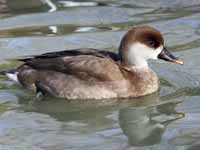
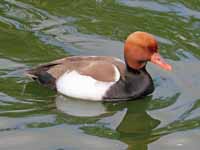
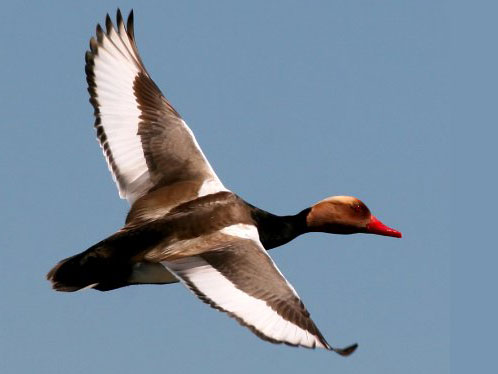
Pochard,_Rosy-billed Netta peposaca
Description: The male rosy-billed pochard, also known as the rosybill, has a pink bill with red bump at the base of the bill. The bill is black tipped. The eyes are red and the back, head, neck, and breast are black. It has vermiculated grey sides and a white rump. The female has brown upperparts, whitish underparts, and a bluish bill with a black tip.
Range: South America (southern).
Habitat: Freshwater swamps, marshes and shallow lakes.
Diet: Aquatic plants, grasses, sedges. It feeds mainly be dabbling or grazing, not diving.
Conservation status: Least Concern.
Image by: 1) )Nick Athanas - Argentina 2) Rachid_H 3) Sandy Cole - Sylvan Heights 4) Dick Daniels - Sylvan Heights Range: South America (southern).
Habitat: Freshwater swamps, marshes and shallow lakes.
Diet: Aquatic plants, grasses, sedges. It feeds mainly be dabbling or grazing, not diving.
Conservation status: Least Concern.
1, 2) Female 3, 4) Male
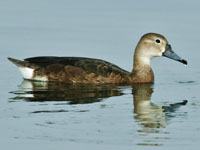
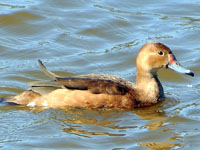
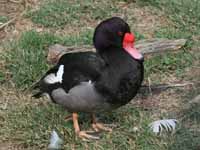
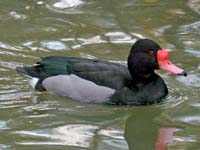
Pochard,_Southern Netta erythrophthalma
Description: The male Southern Pochard has a black head, neck, and breast. His back is drak and the flanks are brown. The female is brown overall with a darker back. She has a white patch at base of her bill, white around most of the eye, a white line behind eye, and a white swirl on the neck.
Range: Sourh America, Africa .
Habitat: Freshwater wetlands, relatively deep.
Diet: Mainly seeds of aquatic plants, but also vegetation. Also crustaceans, mollusks, insects.
Conservation status: Least Concern.
Image by: 1) Regani 2, 3)
Dick Daniels - Sylvan Heights 4) Leo_za1Range: Sourh America, Africa .
Habitat: Freshwater wetlands, relatively deep.
Diet: Mainly seeds of aquatic plants, but also vegetation. Also crustaceans, mollusks, insects.
Conservation status: Least Concern.
1, 2) Female 3, 4) Male
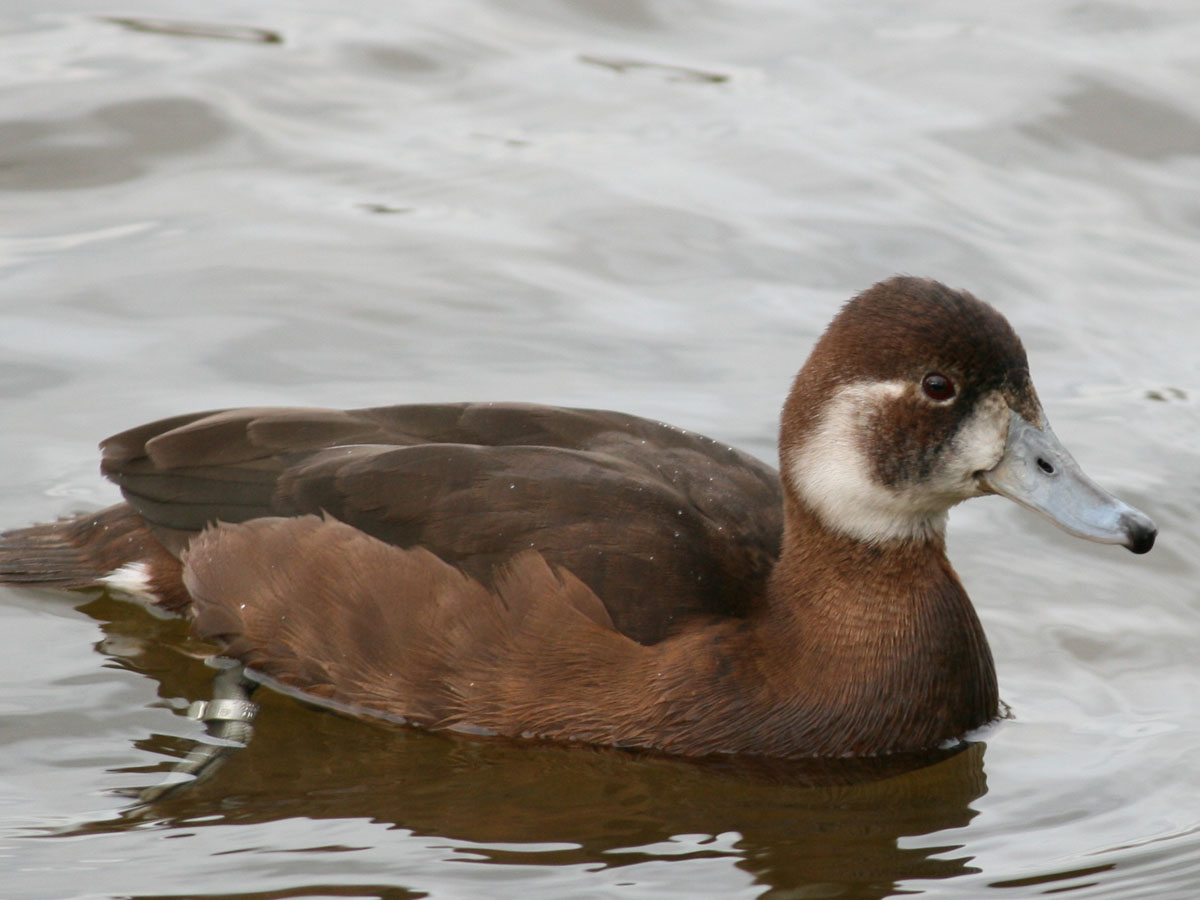
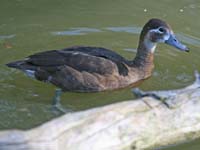

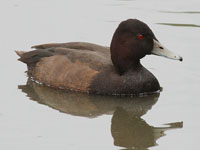
Genus Marmaronetta - 1 species
Duck, Teal Marmaronetta angustirostris
Description: The marbled teal, also known as the marbled duck, is greyish-brown overall with large light spots on upper back and flanks. It has a dark lower back, dark rear part of head, and dark eye patch.
Range: Eurasia (southern), northern Africa.
Habitat: Shallow wetlands, either freshwater or brackish, that have considerable vegetation.
Diet: Mainly seeds, green plants, insect larvae, ants. Forages by dabbling.
Conservation status: The marbled teal is Vulnerable due to habitat destruction and hunting.
Image by: 1, 2)
Dick Daniels - Sylvan Heights 3) Sandy Cole - Sylvan Heights 4) Cristiano Crolle - Racconigi, ItalyRange: Eurasia (southern), northern Africa.
Habitat: Shallow wetlands, either freshwater or brackish, that have considerable vegetation.
Diet: Mainly seeds, green plants, insect larvae, ants. Forages by dabbling.
Conservation status: The marbled teal is Vulnerable due to habitat destruction and hunting.
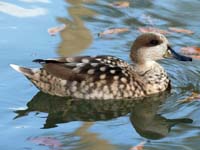

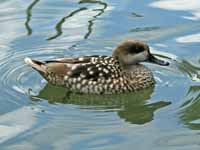
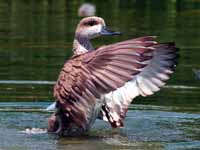
Genus Asarcornis - 1 species
The white-winged duck was formerly include with the muscovy duck in genus Cairina. However it now thought to be closer to diving ducks. It is a very large duck, slightly bigger than the muscovy.
Duck, White-winged Asarcornis scutulata
Description: The white-winged duck, also know as the white-winged wood duck, has a dark brown body plus a white speckled head and neck. Sexes are similar in appearance, but the male is larger.
Range: Southeast Asia.
Habitat: Dense tropical evergreen forests, near rivers and swamps.
Diet: Aquatic plants and seeds, grains, insects, mollusks.
Conservation status: The white-winged duck is Endangered because of habitat loss and hunting.They nest in hollow trees and those trees are being destroyed.
Image by: 1, 2, 3, 4) Dick - Sylvan Heights Range: Southeast Asia.
Habitat: Dense tropical evergreen forests, near rivers and swamps.
Diet: Aquatic plants and seeds, grains, insects, mollusks.
Conservation status: The white-winged duck is Endangered because of habitat loss and hunting.They nest in hollow trees and those trees are being destroyed.
